Sodium is an essential nutrient required by the body for maintaining
levels of fluids and for providing channels of nerve signaling.
Deficiency of sodium is rare, however, can occur in people after
excessive vomiting or diarrhea, in athletes who intake excessive amounts
of water, or in people who regularly fast on juice and water.
Over-consumption of sodium is far more common and can lead to high blood
pressure which in turn leads to an increased risk of heart attack and
stroke. The current percent daily value for sodium is 2400mg, however,
the American Heart Association recommends that people with high blood
pressure eat less that 1500mg per day, or less than 3/4 of a table spoon
of salt. Since sodium is required by all life to exist, it is naturally
found in all foods and rarely does salt ever need to be added. Steps
you can take to ensure low sodium eating include: avoiding canned foods,
avoiding pickled food, choosing low sodium cheeses, and substituting
herbs and other spices in place of salt. Below is a list of high sodium
foods, almost all these foods should be avoided.
#1: Table salt, baking soda, and baking powder
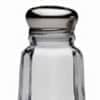 Table
salt is 40% sodium by weight, and easily the number one source of
sodium for almost everyone. 100 grams of table salt (1/3 cup) provides
38,000 mg of sodium or 1615% of the DV. One teaspoon of salt provides
2325mg of sodium or 98% of the DV. One teaspoon of baking soda provides
1368mg of sodium (57% DV), and one teaspoon of baking powder contains
530mg (22% DV).
Table
salt is 40% sodium by weight, and easily the number one source of
sodium for almost everyone. 100 grams of table salt (1/3 cup) provides
38,000 mg of sodium or 1615% of the DV. One teaspoon of salt provides
2325mg of sodium or 98% of the DV. One teaspoon of baking soda provides
1368mg of sodium (57% DV), and one teaspoon of baking powder contains
530mg (22% DV).
 Table
salt is 40% sodium by weight, and easily the number one source of
sodium for almost everyone. 100 grams of table salt (1/3 cup) provides
38,000 mg of sodium or 1615% of the DV. One teaspoon of salt provides
2325mg of sodium or 98% of the DV. One teaspoon of baking soda provides
1368mg of sodium (57% DV), and one teaspoon of baking powder contains
530mg (22% DV).
Table
salt is 40% sodium by weight, and easily the number one source of
sodium for almost everyone. 100 grams of table salt (1/3 cup) provides
38,000 mg of sodium or 1615% of the DV. One teaspoon of salt provides
2325mg of sodium or 98% of the DV. One teaspoon of baking soda provides
1368mg of sodium (57% DV), and one teaspoon of baking powder contains
530mg (22% DV).
#2: Bouillon cubes, Powdered Broths, Soups
 Salt
is widely used as an agent to dry and preserve foods and soup broths
are no exception. A typical 5 gram bouillon cube contains 1200mg of
sodium or 50% of the DV.
Salt
is widely used as an agent to dry and preserve foods and soup broths
are no exception. A typical 5 gram bouillon cube contains 1200mg of
sodium or 50% of the DV.
 Salt
is widely used as an agent to dry and preserve foods and soup broths
are no exception. A typical 5 gram bouillon cube contains 1200mg of
sodium or 50% of the DV.
Salt
is widely used as an agent to dry and preserve foods and soup broths
are no exception. A typical 5 gram bouillon cube contains 1200mg of
sodium or 50% of the DV.
#3: Soy Sauce, Other Sauces, and Salad Dressings
 Soy
sauce is commonly added to East Asian cooking, and now comes in low
sodium varieties which are recommended, check nutrition facts of
specific products for sodium content. One teaspoon of Tamari (Soy only)
soy sauce contains 335mg (14% DV) and one teaspoon of Shoyu (Wheat and
Soy) Soy Sauce contains 282mg of sodium (12% DV). In addition to soy
sauces, be sure to check labels of most sauces and salad dressings in
general, as these foods can be surprising high in sodium.
Soy
sauce is commonly added to East Asian cooking, and now comes in low
sodium varieties which are recommended, check nutrition facts of
specific products for sodium content. One teaspoon of Tamari (Soy only)
soy sauce contains 335mg (14% DV) and one teaspoon of Shoyu (Wheat and
Soy) Soy Sauce contains 282mg of sodium (12% DV). In addition to soy
sauces, be sure to check labels of most sauces and salad dressings in
general, as these foods can be surprising high in sodium.
 Soy
sauce is commonly added to East Asian cooking, and now comes in low
sodium varieties which are recommended, check nutrition facts of
specific products for sodium content. One teaspoon of Tamari (Soy only)
soy sauce contains 335mg (14% DV) and one teaspoon of Shoyu (Wheat and
Soy) Soy Sauce contains 282mg of sodium (12% DV). In addition to soy
sauces, be sure to check labels of most sauces and salad dressings in
general, as these foods can be surprising high in sodium.
Soy
sauce is commonly added to East Asian cooking, and now comes in low
sodium varieties which are recommended, check nutrition facts of
specific products for sodium content. One teaspoon of Tamari (Soy only)
soy sauce contains 335mg (14% DV) and one teaspoon of Shoyu (Wheat and
Soy) Soy Sauce contains 282mg of sodium (12% DV). In addition to soy
sauces, be sure to check labels of most sauces and salad dressings in
general, as these foods can be surprising high in sodium.
#4: Salami and Cured Meats
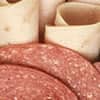 Salt
has long been used as a preservative for various meats, and so it is
not surprising to find a high amount of sodium in them. One slice of
bacon (8 grams) contains 194mg of sodium (8% DV), while one slice of
salami (10g) contains 226mg (9% DV), and 1 large piece of beef jerky
(20g) contains 443mg of sodium or 18% DV.
Salt
has long been used as a preservative for various meats, and so it is
not surprising to find a high amount of sodium in them. One slice of
bacon (8 grams) contains 194mg of sodium (8% DV), while one slice of
salami (10g) contains 226mg (9% DV), and 1 large piece of beef jerky
(20g) contains 443mg of sodium or 18% DV.
 Salt
has long been used as a preservative for various meats, and so it is
not surprising to find a high amount of sodium in them. One slice of
bacon (8 grams) contains 194mg of sodium (8% DV), while one slice of
salami (10g) contains 226mg (9% DV), and 1 large piece of beef jerky
(20g) contains 443mg of sodium or 18% DV.
Salt
has long been used as a preservative for various meats, and so it is
not surprising to find a high amount of sodium in them. One slice of
bacon (8 grams) contains 194mg of sodium (8% DV), while one slice of
salami (10g) contains 226mg (9% DV), and 1 large piece of beef jerky
(20g) contains 443mg of sodium or 18% DV.
#5: Sun Dried Tomatoes
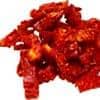 Sun
Dried Tomatoes are delicious in a sandwich or as an ingredient in pasta
sauce. 100 grams (about 2 cups) will provide 2095mg of sodium or 87% of
the DV. A single piece (2g) contains 42mg of sodium (2% DV).
Sun
Dried Tomatoes are delicious in a sandwich or as an ingredient in pasta
sauce. 100 grams (about 2 cups) will provide 2095mg of sodium or 87% of
the DV. A single piece (2g) contains 42mg of sodium (2% DV).
 Sun
Dried Tomatoes are delicious in a sandwich or as an ingredient in pasta
sauce. 100 grams (about 2 cups) will provide 2095mg of sodium or 87% of
the DV. A single piece (2g) contains 42mg of sodium (2% DV).
Sun
Dried Tomatoes are delicious in a sandwich or as an ingredient in pasta
sauce. 100 grams (about 2 cups) will provide 2095mg of sodium or 87% of
the DV. A single piece (2g) contains 42mg of sodium (2% DV).
#6: Cheese
 Most cheeses are packed with sodium, and combined with high cholesterol levels, can be a disaster for your heart and cardiovascular health.
The cheeses with the most sodium per 100 gram serving (about 5 one inch
cubes) are Roquefort (75% DV), Cheez Whiz (71% DV), Parmesan (71% DV),
Cheddar (66% DV), Swiss (65% DV), Blue (58% DV), Romano (50% DV), Feta
(47% DV), Edam (40% DV), Provolone (37% DV), Camembert (35% DV), Gouda
(34% DV), Fontina (33% DV), Limburger (33% DV), Mexican blend (32% DV),
Tilsit (31% DV), and Mozzarella (31% DV).
Most cheeses are packed with sodium, and combined with high cholesterol levels, can be a disaster for your heart and cardiovascular health.
The cheeses with the most sodium per 100 gram serving (about 5 one inch
cubes) are Roquefort (75% DV), Cheez Whiz (71% DV), Parmesan (71% DV),
Cheddar (66% DV), Swiss (65% DV), Blue (58% DV), Romano (50% DV), Feta
(47% DV), Edam (40% DV), Provolone (37% DV), Camembert (35% DV), Gouda
(34% DV), Fontina (33% DV), Limburger (33% DV), Mexican blend (32% DV),
Tilsit (31% DV), and Mozzarella (31% DV).
 Most cheeses are packed with sodium, and combined with high cholesterol levels, can be a disaster for your heart and cardiovascular health.
The cheeses with the most sodium per 100 gram serving (about 5 one inch
cubes) are Roquefort (75% DV), Cheez Whiz (71% DV), Parmesan (71% DV),
Cheddar (66% DV), Swiss (65% DV), Blue (58% DV), Romano (50% DV), Feta
(47% DV), Edam (40% DV), Provolone (37% DV), Camembert (35% DV), Gouda
(34% DV), Fontina (33% DV), Limburger (33% DV), Mexican blend (32% DV),
Tilsit (31% DV), and Mozzarella (31% DV).
Most cheeses are packed with sodium, and combined with high cholesterol levels, can be a disaster for your heart and cardiovascular health.
The cheeses with the most sodium per 100 gram serving (about 5 one inch
cubes) are Roquefort (75% DV), Cheez Whiz (71% DV), Parmesan (71% DV),
Cheddar (66% DV), Swiss (65% DV), Blue (58% DV), Romano (50% DV), Feta
(47% DV), Edam (40% DV), Provolone (37% DV), Camembert (35% DV), Gouda
(34% DV), Fontina (33% DV), Limburger (33% DV), Mexican blend (32% DV),
Tilsit (31% DV), and Mozzarella (31% DV).
#7: Snack Foods (Pretzels, Cheese Puffs, and Popcorn)
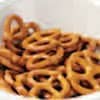 It should not be news that most processed snack foods are bad for you,
and their high sodium content is just another reason not to eat them.
100 grams of pretzels (15 medium twists) contain 1715mg (71% DV) of
sodium. Cheese puffs (~15% DV per oz) and regular popcorn (~12% DV per
oz) are just as bad. As with all snack foods, be sure to check the
labels for specific information.
It should not be news that most processed snack foods are bad for you,
and their high sodium content is just another reason not to eat them.
100 grams of pretzels (15 medium twists) contain 1715mg (71% DV) of
sodium. Cheese puffs (~15% DV per oz) and regular popcorn (~12% DV per
oz) are just as bad. As with all snack foods, be sure to check the
labels for specific information.
 It should not be news that most processed snack foods are bad for you,
and their high sodium content is just another reason not to eat them.
100 grams of pretzels (15 medium twists) contain 1715mg (71% DV) of
sodium. Cheese puffs (~15% DV per oz) and regular popcorn (~12% DV per
oz) are just as bad. As with all snack foods, be sure to check the
labels for specific information.
It should not be news that most processed snack foods are bad for you,
and their high sodium content is just another reason not to eat them.
100 grams of pretzels (15 medium twists) contain 1715mg (71% DV) of
sodium. Cheese puffs (~15% DV per oz) and regular popcorn (~12% DV per
oz) are just as bad. As with all snack foods, be sure to check the
labels for specific information.
#8: Pickled Foods
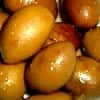 Pickled
foods are typically pickled with salt and thus have very high sodium
contents. 100 grams of olives, for example, will provide 1556mg (65% DV)
of sodium. That is 3% of the DV per large olive, or 1/5 of your total
percent daily value in 7 olives! As for dill pickles, a single large
pickle will pack half of the DV for sodium!
Pickled
foods are typically pickled with salt and thus have very high sodium
contents. 100 grams of olives, for example, will provide 1556mg (65% DV)
of sodium. That is 3% of the DV per large olive, or 1/5 of your total
percent daily value in 7 olives! As for dill pickles, a single large
pickle will pack half of the DV for sodium!
 Pickled
foods are typically pickled with salt and thus have very high sodium
contents. 100 grams of olives, for example, will provide 1556mg (65% DV)
of sodium. That is 3% of the DV per large olive, or 1/5 of your total
percent daily value in 7 olives! As for dill pickles, a single large
pickle will pack half of the DV for sodium!
Pickled
foods are typically pickled with salt and thus have very high sodium
contents. 100 grams of olives, for example, will provide 1556mg (65% DV)
of sodium. That is 3% of the DV per large olive, or 1/5 of your total
percent daily value in 7 olives! As for dill pickles, a single large
pickle will pack half of the DV for sodium!